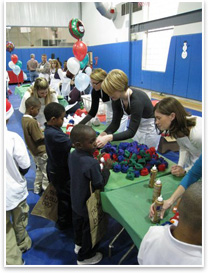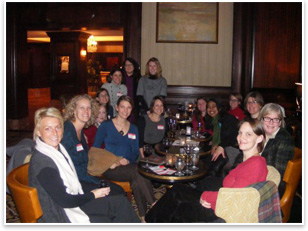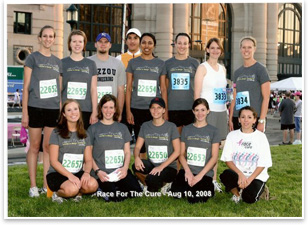MEMBER-TO-MEMBER
Kansas City Women in Design Work Together to Implement Mentoring Programs
by Erin Olson-Douglas, AIA
Young Architects Forum Central States Liaison
 Summary: Women in Design Kansas City (WiD-KC) is a community of women involved in architecture and the design professions who have come together for mentorship, support, and advocacy for women in design. The organization provides opportunities for working with the community to educate, enhance, explore, and celebrate the historic and present contributions of women in our professions through community outreach, mentorship, programs, and research. Summary: Women in Design Kansas City (WiD-KC) is a community of women involved in architecture and the design professions who have come together for mentorship, support, and advocacy for women in design. The organization provides opportunities for working with the community to educate, enhance, explore, and celebrate the historic and present contributions of women in our professions through community outreach, mentorship, programs, and research.
Deep roots
Kansas City’s Women in Design organization began with a fundamental question that many young professionals face: How do I do all of these things that I love? This question began as a conversation among a few young women in Kansas City who were confronting this issue.
The question then was posed to more seasoned designers to gather their wisdom from navigating their successful balance of careers and family life. Early in 2005, the conversation grew into the formation of a multidisciplinary group of young women designers who drew insight from a spectrum of experience levels. The founding group of young women met with their more seasoned female colleagues who shared their wisdom, helping to identify a core mission, potential programs, and pitfalls that they encountered. They also identified a latent resource: an unusually strong collection of women architects who had practiced in Kansas City and/or left a legacy of built work in Kansas City early in the 1900s. Without yet forming the clear structure with a board and committees that exists today, the founding group had ideas that they wanted to explore—mentorship, community outreach, and advocacy issues—and celebrate the historic and current contributions of women who contribute to the built environment in Kansas City.
Women in Design Kansas City officially launched in April 2005. The organization is financially supported by sponsors, many of which are firms that employ the group’s founders and current leaders. WiD-KC has officially become a committee of the AIA-Kansas City component. They now have a four-person board with eight committee chairwomen representing community outreach, membership, communications, Web site, mentorship, history/roots, programs, and sponsorship.
 Multiple mentoring programs Multiple mentoring programs
Mentoring formed the basis of WiD-KC’s founding. WiD-KC’s mentorship activities focus on serving women in three groups: high school students interested in pursuing careers in the built environment, college students in design programs, and young professionals in design and construction fields. They have explored several avenues for implementing mentorship in their community, including:
1. Day of Shadowing: The Day of Shadowing program was created to introduce careers in the built environment to high school students. WiD-KC works with high schools in the region to pair students with firms and companies that match their interests. The program builds on a mandate for career shadowing in Kansas City schools and offers students the possibility of seeing the careers of architects, contractors, engineers, and other design-related professions. A single day in the fall is identified and firms sign up to take up to 10 students for a half day of job shadowing.
2. Mentor matching: The goal of this mentoring network is to provide a platform for women within WiD-KC and area college students to seek guidance and information about their chosen profession as they progress through their career. All interested members and students are required to fill out an on-line Mentee Survey to help with the matching process. Meanwhile, mentors are solicited from WiD-KC’s membership. Potential mentors are also required to submit a survey. In submitting their survey, mentors indicate agreement that they will devote adequate time to their assigned mentee, recommended at a minimum of four meetings annually.
The mentorship committee reviews the surveys and identifies a mentor for each mentee. The mentorship committee then contacts the mentor with information about the mentee and the mentor is expected to make the first contact with the mentee. Mentor and mentee are provided with a brief orientation guide that outlines expectations of each role. Mentor and mentee relationships may be continued indefinitely. Assessment forms provide an opportunity for each mentor and mentee to reflect on the relationship. Wid-KC continues to build a database of available mentors for ongoing requests by mentees. The matching program is identified on WiD-KC’s Web site. Links to the requisite survey applications, an orientation guide, and assessment form are all available on their Web site.
3. Special events: WiD-KC never aimed to be an exclusively female organization. They offer a range of events that are broadly advertised and attract a diverse audience and participation. They anecdotally report that their events draw a 50/50 male/female attendance at outings such as building tours and speakers. WiD-KC engages in a range of community outreach events, including a Race for the Cure team and Habitat for Humanity. The group created a trolley tour that highlights important architectural contributions designed by significant women architects in Kansas City. The tour is sought by a range of interest groups and visiting conventions.
4. Mentor luncheons: Every other month, WiD-KC plans topical mentor lunches at the AIA Kansas City office. The lunches are free, but limited to an attendance of 25 people to help ensure robust conversation. A panel is formed around the given topic. Sometimes these panels include a variety of personal experiences with the topic, sometimes they include experts invited to speak on the chosen subject. Recent topics of the luncheons have included: business development, life/work balance, and professional licensure.
 The evolving nature of mentoring The evolving nature of mentoring
The spectrum of mentorship opportunities offered by WiD-KC represents an ever-evolving understanding of how mentorship works best for young women in design fields. Each program has enjoyed its own successes.
The group continually requests input on current program and uses feedback and critical reflection to develop new avenues for their members. The Day of Shadowing and Mentor Matching were their first mentorship efforts. As they noted that requests for mentor matching leveled out, they sought connections with nearby colleges and universities and extended their program to design students. When they were getting feedback from seasoned women professionals that they were somewhat reluctant to commit to leadership positions in the group or indefinite mentoring relationships, WiD-KC began their Mentor Luncheons series to accommodate the busy schedules of these members while still providing mentorship opportunities and drawing out the wisdom that many of these members had to offer.
WiD-KC’s members realized that a number of the issues they were discussing—for example, work/life balance or community involvement—were not gender specific and they looked to broaden their participation. Special events and a number of WiD-KC’s outreach efforts grew out of a desire to broaden their membership and reach out to potential new participants while putting their skills to work for community betterment and gaining notoriety for their organization.
WiD-KC’s self-assessment and quest for improving mentoring opportunities for young women in their area is ongoing. They are currently in the process of creating and fostering a Women in Design group at Kansas University and building a “YouthFriends” outlet that provides speakers to area schools to talk about various career opportunities in the design fields. Their communications network is strong, offering a well-publicized annual calendar of events and monthly newsletters all available on their Web site.
|


 Summary:
Summary: Multiple mentoring programs
Multiple mentoring programs The evolving nature of mentoring
The evolving nature of mentoring